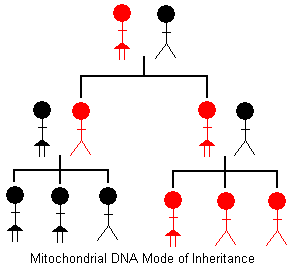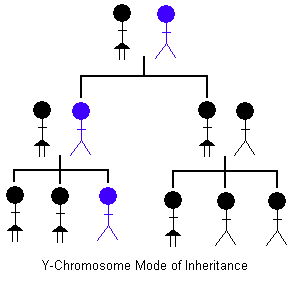Ancestry Testing
Maternal Ancestry Testing
Trace your maternal lineage with mitochondrial DNA (mtDNA). Mitochondrial DNA is passed down from mother to offspring. Only females can pass on mtDNA. Individuals that have a common maternal ancestor will have the same mtDNA profile.

Mitochondrial DNA does not change over many generations. It gives information about deep ancestry hundreds of generations ago, not recent ancestry a few generations back. A mother will pass mtDNA on to her children but only the females continue to pass it on. Why? Going back to the fertilization process inside the womb, a female egg contains both nuclear and mitochondrial DNA. A sperm contains nuclear DNA in the head and mtDNA in the tail. As the sperm enters the egg, its tail is cleaved off, and therefore the tail does not enter the egg only the head does. The male mtDNA does not enter the egg. Only the female mtDNA is present in the egg as it grows.
The Paleo-DNA Laboratory is a leading expert in mitochondrial DNA analysis. We can help you discover information about your maternal ancestry or compare mtDNA profiles to determine if two or more individuals share a common maternal ancestry.
Your mtDNA profile is reported as differences or mutations in your mitochondrial DNA sequence from a universal mitochondrial DNA reference sequence called the Revised Cambridge Reference Sequence (RCRS). The genetic data is presented as the position of the mutation in the mitochondrial genome (i.e. 16223) and base call (i.e. A, G, C, T) of the mutation compared to the RCRS. Three areas can be studied for ancestry within the mtDNA; hypervariable region I (positions 16000-16400), hypervariable region II (positions 15-400), and hypervariable region III (positions 400-600). Below is an example of a mtDNA profile for hypervariable regions I and II in comparison to the RCRS.

'RCRS' is the Revised Cambridge Reference Sequence,
'-' means base position is not defined
John Doe's mtDNA profile can also be written as: HV1 16189C, 16223T, 16362C, 16398A and HV2 73G, 150T, 263G, 309.1C. This mtDNA profile can be placed into a category or 'haplogroup'. A haplogroup is a group of individuals that share similarities within their mtDNA profile. A haplogroup has specific origin throughout the world that can be dated as far back as 100,000 years. The more information gathered for one's mtDNA profile, the more certain a haplogroup can be predicted.
Paternal Ancestry Testing
Trace your paternal lineage (male lineage) with Y-chromosomal DNA. The Y-chromosome is passed down from father to son. Male individuals that have a common paternal ancestor will have the same Y-chromosomal profile. Since only male individuals have a Y-chromosome, this test can only be performed on males.

Y-chromosomal DNA does not change over many generations. It gives information about deep ancestry hundreds of generations ago, not recent ancestry a few generations back. Y-chromosomal DNA is passed down from father to son. Why? Looking at the sex chromosomes that determine gender, females have two X chromosomes, males have an X and Y chromosome. The same Y chromosome is passed on from generation to generation. The Paleo-DNA Laboratory can help you discover information about your paternal ancestry or compare two or more individuals to determine whether they share a common paternal ancestry.
For this test, 23 common markers (DYS) of the Y-chromosome are analyzed. Each marker typically contains one piece of numerical information; however, more than one piece of information may be present.

The information at each marker represents the number of times a short sequence of DNA bases is repeated at a specific location on the Y-chromosome. For example, let's look at a 4 basepair short sequence of DNA (i.e. A G G T) at position DYSxxx. At this location what we see is the sequence:
CCAGGTAGGTAGGTAGGTAGGTCTT
From this example the short sequence AGGT is repeated a total of 5 times at this location. Therefore the information we get at marker DYSxxx is '5'.
This Y-chromosome profile can be placed into a category or 'haplogroup'. A haplogroup is a group of individuals that share similarities within their Y-chromosome profile. A haplogroup has a specific origin throughout the world that can be dated as far back as 100,000 years. The more information gathered for one's Y-chromosome profile, the more certain a haplogroup can be predicted.
Contact us for more information on Ancestry Testing

